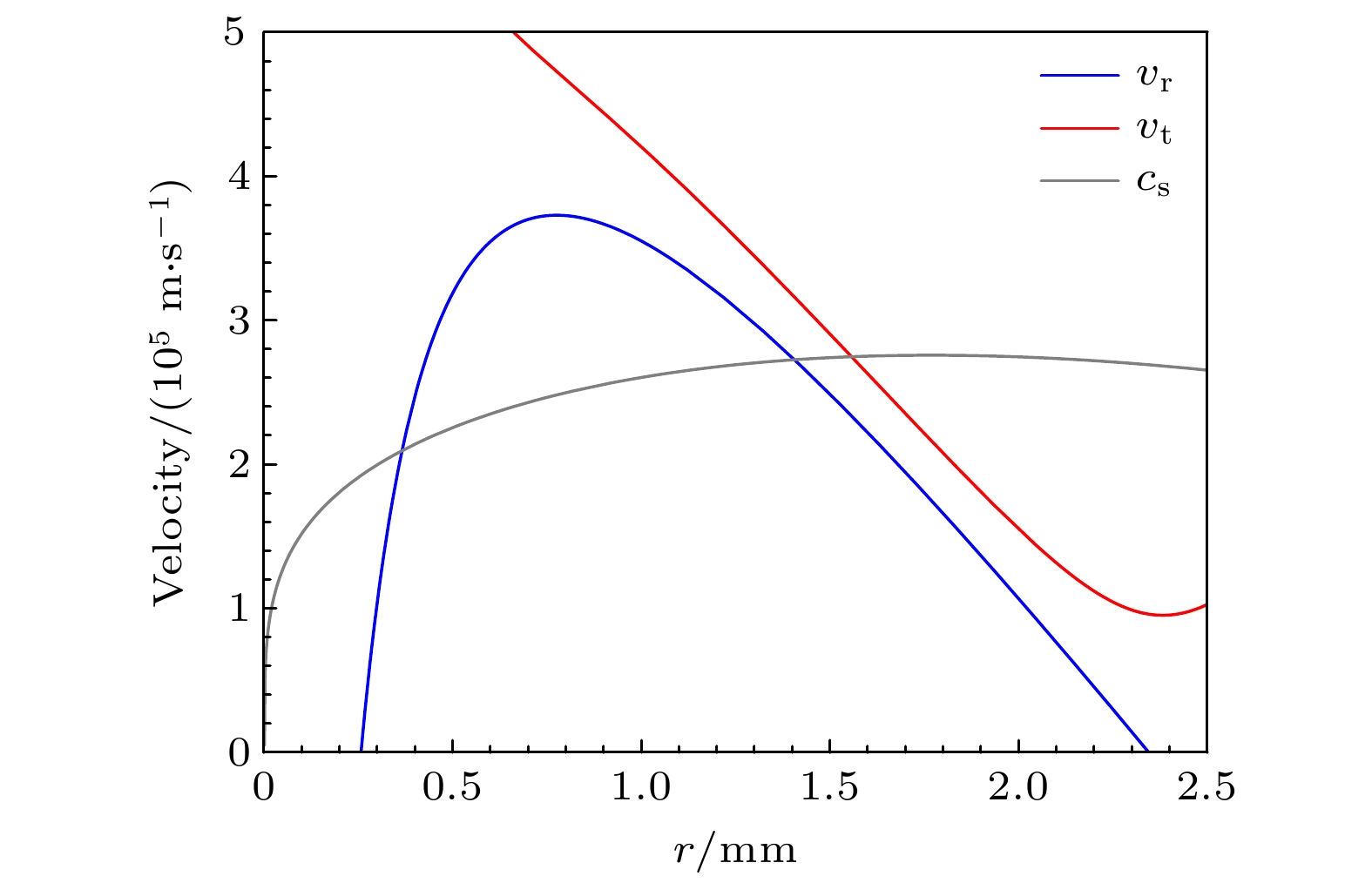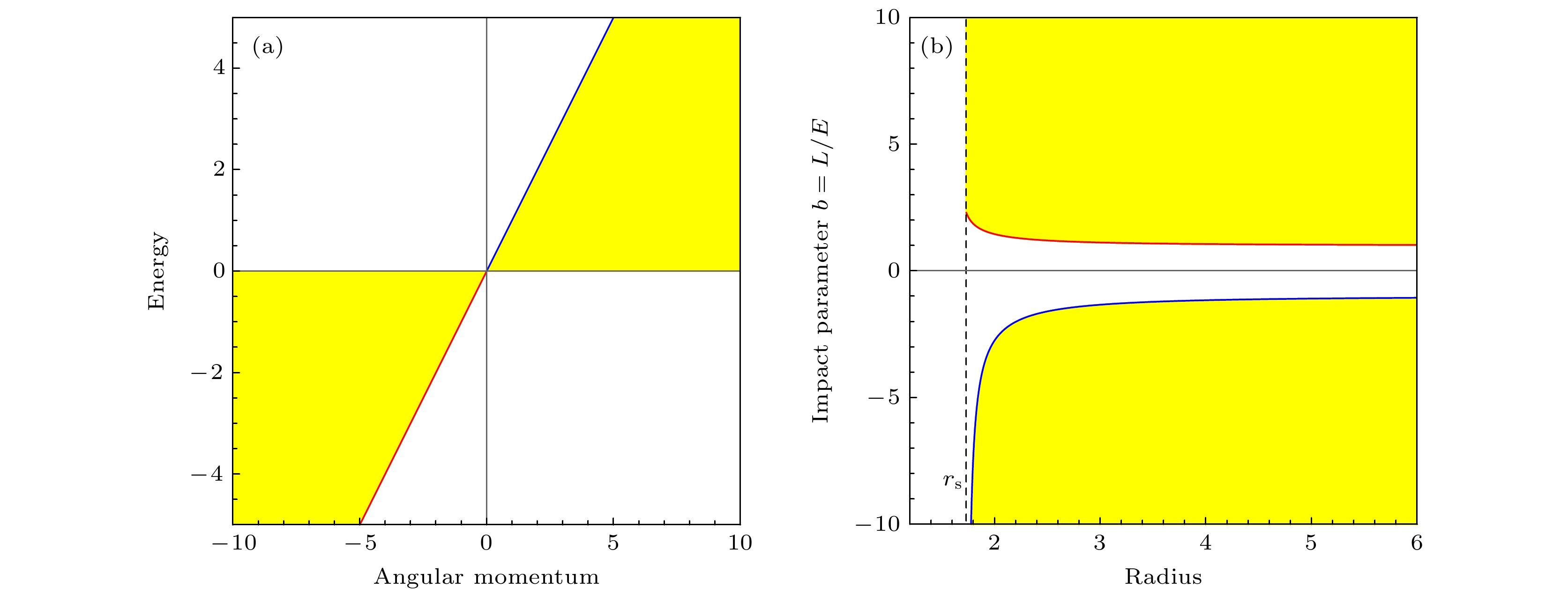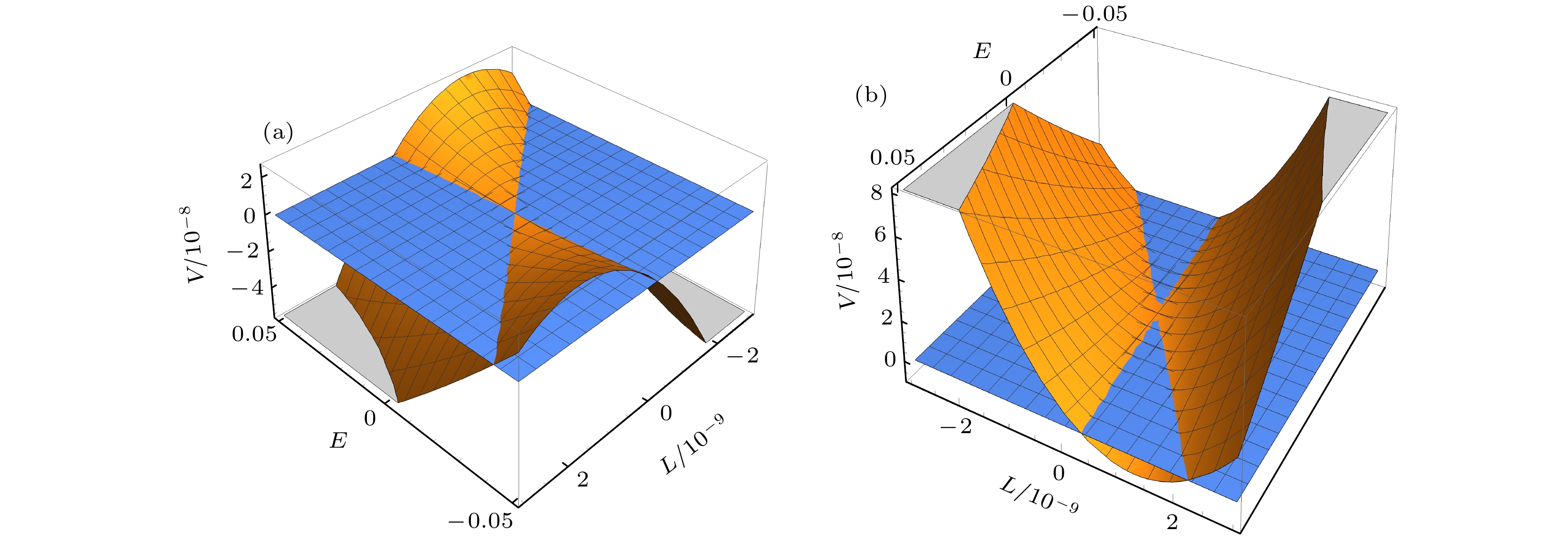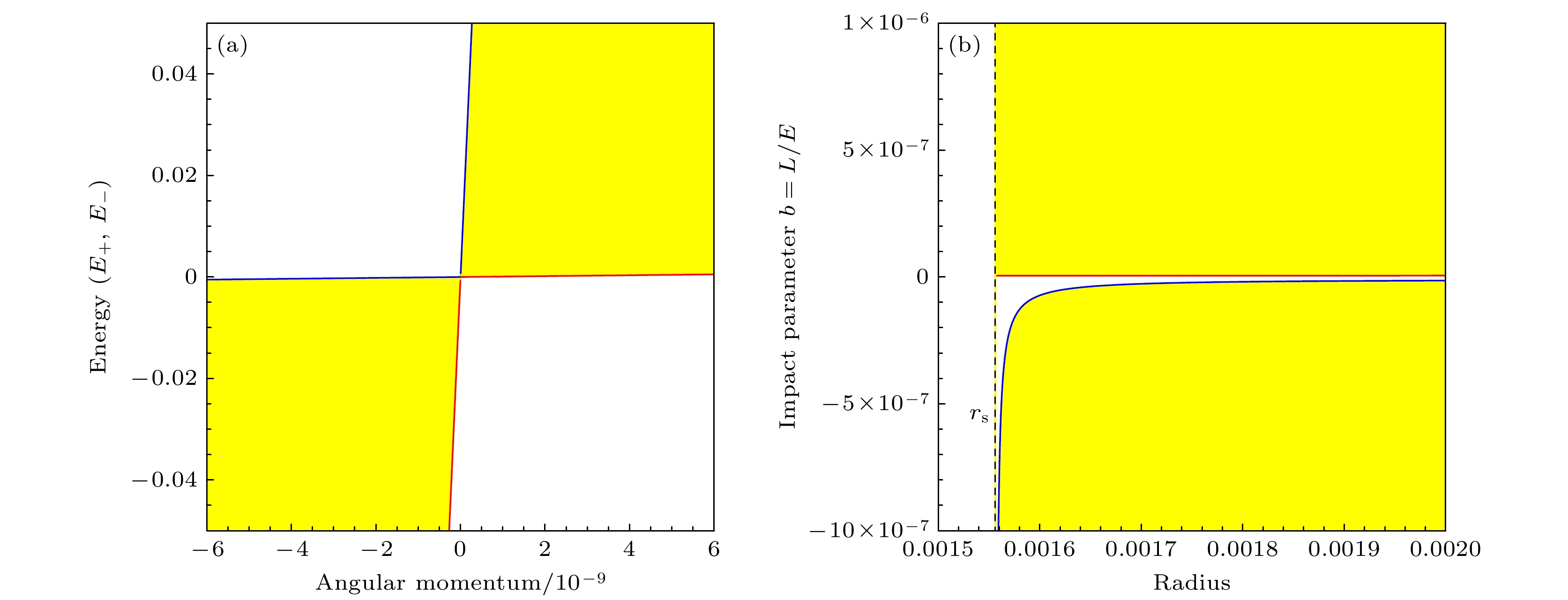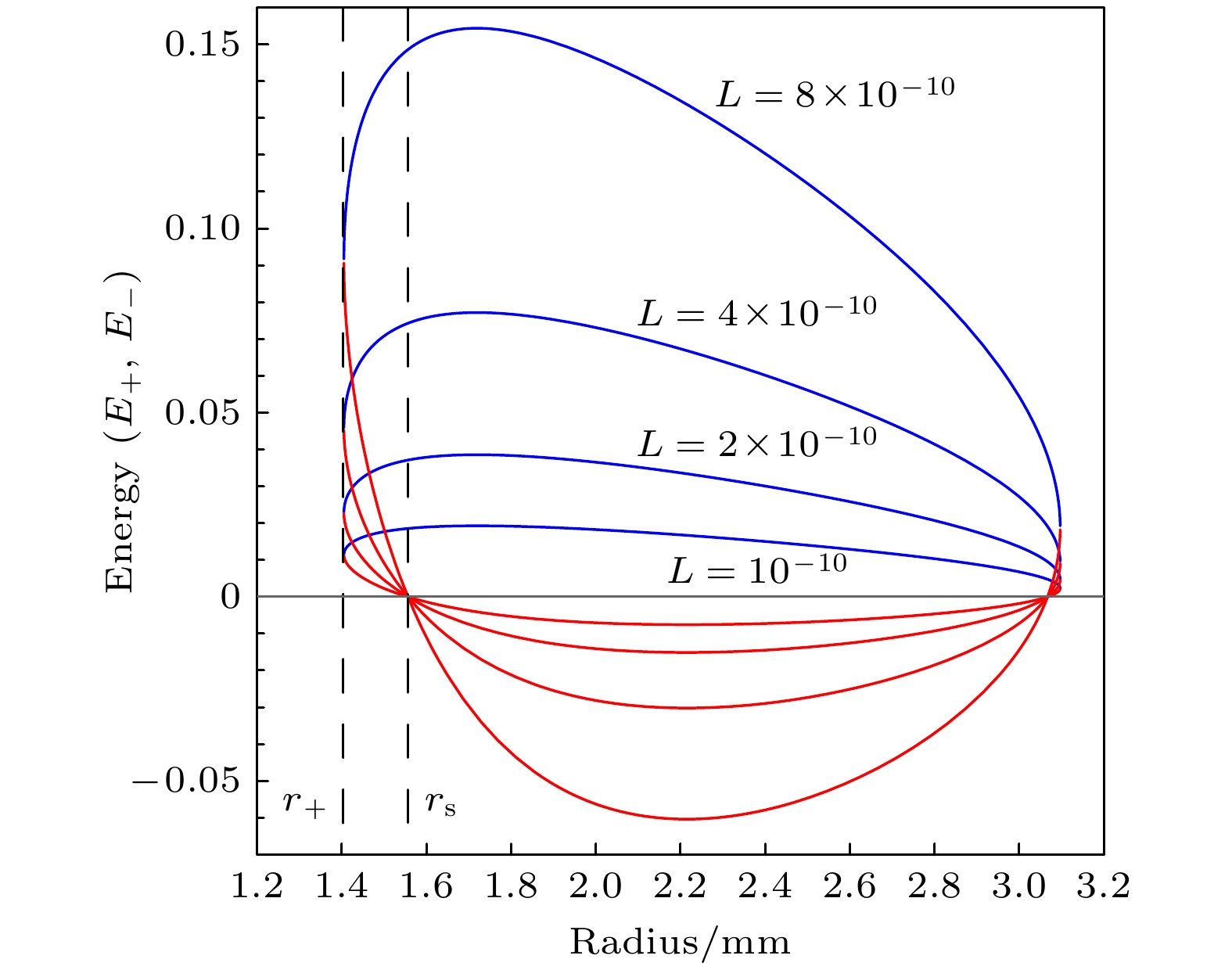-
虽然类比引力理论表明可以使用实验室的物理系统类比黑洞的时空结构, 但是旋转黑洞的结构很难在实验室体系中找到较好的对应. 本文使用特设的涡旋光, 在理论上找到了一种接近Bañados-Teitelboim-Zanelli (BTZ)黑洞的类比结构, 通过计算无质量粒子和声波在类比 BTZ 黑洞和引力的 BTZ 黑洞时空中的运动来比较它们的异同. 两种黑洞时空无质量粒子和声波的有效势能给出了相同的能量和角动量的辐射禁区分布, 不同的是, BTZ 黑洞经典禁区沿径向将趋近固定的能量值, 而类比BTZ 黑洞的经典禁区沿径向将闭合. 幸运的是, 在视界和能层附近, 无质量粒子和声波的运动行为几乎一致, 从这个角度来说, 类比实验体系能够很好地模拟BTZ黑洞. 特别地, 在两种黑洞时空下, 低能量高角动量的粒子的经典禁区都更宽.
-
关键词:
- Bañados-Teitelboim-Zanelli黑洞 /
- 类比黑洞 /
- 涡旋光 /
- 经典禁区
Although the theory of analog gravity suggests that we can simulate the space-time structure of black holes by using laboratory physical systems, it is difficult to find the analogs for rotating black holes in laboratory systems. In this work, we use a new field form for the optical vortex to study the analogous black hole structure close to the Bañados-Teitelboim-Zanelli (BTZ) black hole. We compare the similarities and differences between massless particles and sound waves by calculating their motions in space-time analogous to BTZ black holes and gravitational BTZ black holes. The effective potential energy values of massless particles and sound waves in both kinds of black hole spacetimes give the same forbidden-zone distributions of energy and angular momentum. The difference is that the classical forbidden area of the BTZ black hole will approach fixed energy values along the radial direction, while the classical forbidden area of the analogous BTZ black hole will be closed along the radial direction. Fortunately, near the event horizon and the ergosphere, the behaviors of massless particles and sound waves are almost the same. From this point of view, we can say that the analogous experimental system can simulate the BTZ black hole very well. In particular, the classically forbidden regions of particles with low energy and high angular momentum are wider in both types of black hole space-time.-
Keywords:
- Bañados-Teitelboim-Zanelli black hole /
- analog black hole /
- optical vortex /
- classically forbidden regions
[1] Unruh W G 1981 Phys. Rev. Lett. 46 1351
 Google Scholar
Google Scholar
[2] Hawking S W 1974 Nature 248 30
 Google Scholar
Google Scholar
[3] Lahav O, Itah A, Blumkin A, Gordon C, Rinott S, Zayats A, Steinhauer J 2010 Phys. Rev. Lett. 105 240401
 Google Scholar
Google Scholar
[4] Nguyen H S, Gerace D, Carusotto I, Sanvitto D, Galopin E, Lemaître A, Sagnes I, Bloch J, Amo A 2015 Phys. Rev. Lett. 114 036402
 Google Scholar
Google Scholar
[5] Euvé L P, Michel F, Parentani R, Philbin T G, Rousseaux G 2016 Phys. Rev. Lett. 117 121301
 Google Scholar
Google Scholar
[6] Painlevé P 1921 C. R. Acad. Sci. , Paris 173 677
[7] Gullstrand A 1922 Ark. Mat. Astron. Fys. 16 1
[8] Lemaître G 1933 Ann. Soc. Sci. Brux. A 53 51
[9] Robertson S J 2012 J. Phys. B: At. Mol. Opt. Phys. 45 163001
 Google Scholar
Google Scholar
[10] Garza P, Kabat D, van Gelder A 2018 Class. Quantum Grav. 35 165009
 Google Scholar
Google Scholar
[11] Zhang B 2016 Adv. High Energy Phys. 2016 5710625
[12] Visser M 1998 Class. Quantum Grav. 15 1767
 Google Scholar
Google Scholar
[13] Penrose R, Floyd R M 1971 Nat. Phys. Sci. 229 177
 Google Scholar
Google Scholar
[14] Fagnocchi S, Finazzi S, Liberati S, Kormos M, Trombettoni A 2010 New J. Phys. 12 095012
 Google Scholar
Google Scholar
[15] Kroon J A V 2004 Phys. Rev. Lett. 92 041101
 Google Scholar
Google Scholar
[16] Visser M, Weinfurtner S 2005 Class. Quantum Grav. 22 2493
 Google Scholar
Google Scholar
[17] Berti E, Cardoso V, Lemos J P S 2004 Phys. Rev. D 70 124006
 Google Scholar
Google Scholar
[18] Carusotto I, Ciuti C 2013 Rev. Mod. Phys. 85 299
 Google Scholar
Google Scholar
[19] Braidotti M C, Faccio D, Wright E M 2020 Phys. Rev. Lett. 125 193902
 Google Scholar
Google Scholar
[20] Ornigotti M, Bar-Ad S, Szameit A, Fleurov V 2018 Phys. Rev. A 97 013823
 Google Scholar
Google Scholar
[21] Prodanov E M 2014 Class. Quantum Grav. 31 105013
 Google Scholar
Google Scholar
[22] Mc Caughey E 2016 Eur. Phys. J. C 76 179
 Google Scholar
Google Scholar
[23] Gillani U A, Saifullah K 2021 Astropart. Phys. 125 102496
 Google Scholar
Google Scholar
[24] Banados M, Teitelboim C, Zanelli J 1992 Phys. Rev. Lett. 69 1849
 Google Scholar
Google Scholar
[25] Giacomelli L, Liberati S 2017 Phys. Rev. D 96 064014
 Google Scholar
Google Scholar
[26] Townsend P K, Zhang B 2013 Phys. Rev. Lett. 110 241302
 Google Scholar
Google Scholar
[27] Zhang B 2013 Phys. Rev. D 88 124017
 Google Scholar
Google Scholar
[28] Liang C, Gong L, Zhang B 2017 Class. Quantum Grav. 34 035017
 Google Scholar
Google Scholar
[29] Carlip S 1998 Class. Quantum Grav. 15 3609
 Google Scholar
Google Scholar
[30] Visser M 1998 Phys. Rev. Lett. 80 3436
 Google Scholar
Google Scholar
[31] Garay L J, Anglin J R, Cirac J I, Zoller P 2000 Phys. Rev. Lett. 85 4643
 Google Scholar
Google Scholar
[32] Marino F 2008 Phys. Rev. A 78 063804
 Google Scholar
Google Scholar
[33] Marino F, Ciszak M, Ortolan A 2009 Phys. Rev. A 80 065802
 Google Scholar
Google Scholar
[34] Prain A, Maitland C, Faccio D, Marino F 2019 Phys. Rev. D 100 024037
 Google Scholar
Google Scholar
[35] Boyd R W 2020 Nonlinear Optics (4th Ed.) (New York: Academic Press) pp65–69
[36] Braidotti M C, Prizia R, Maitland C, Marino F, Prain A, Starshynov I, Westerberg N, Wright E M, Faccio D 2022 Phys. Rev. Lett. 128 013901
 Google Scholar
Google Scholar
[37] Vocke D, Roger T, Marino F, Wright E M, Carusotto I, Clerici M, Faccio D 2015 Optica 2 484
 Google Scholar
Google Scholar
[38] Vocke D, Maitland C, Prain A, Wilson K E, Biancalana F, Wright E M, Marino F, Faccio D 2018 Optica 5 1099
 Google Scholar
Google Scholar
[39] Yan J 2021 Phys. Lett. B 818 136359
 Google Scholar
Google Scholar
[40] Heckenberg N R, McDuff R, Smith C P, White A G 1992 Opt. Lett. 17 221
 Google Scholar
Google Scholar
[41] McGloin D, Spalding G C, Melville H, Sibbett W, Dholakia K 2003 Opt. Express 11 158
 Google Scholar
Google Scholar
[42] Ostrovsky A S, Rickenstorff-Parrao C, Arrizón V 2013 Opt. Lett. 38 34
 Google Scholar
Google Scholar
[43] Farina C, Gamboa J, Segui-Santonja A J 1993 Class. Quantum Grav. 10 L193
 Google Scholar
Google Scholar
[44] Wilkins D C 1972 Phys. Rev. D 5 814
[45] Chandrasekhar S 1983 The Mathematical Theory of Black Holes (New York: Oxford university press) pp342–347
[46] Cebeci H, Özdemir N, Şentorun S 2016 Phys. Rev. D 93 104031
 Google Scholar
Google Scholar
[47] Banados M, Henneaux M, Teitelboim C, Zanelli J 1993 Phys. Rev. D 48 1506
[48] Cruz N, Martinez C, Pena L 1994 Class. Quantum Grav. 11 2731
 Google Scholar
Google Scholar
[49] Solnyshkov D D, Leblanc C, Koniakhin S V, Bleu O, Malpuech G 2019 Phys. Rev. B 99 214511
 Google Scholar
Google Scholar
-
图 2 涡旋光模拟旋转BTZ黑洞的流体速度(
${\rho _0} = 1.4 \times $ $ {10^5}{\text{ W}}/{{\text{m}}^2}, \sigma = 5{\text{ mm}}, {n_0} = 1.5, \left| {{n_2}} \right| = 4.4 \times {10^{ - 11}}{\text{ }}{{\text{m}}^2}/{\text{W}}$ )Fig. 2. Fluid velocity that analogs to a spinning BTZ black hole by the optical vortex (
${\rho _0} = 1.4 \times {10^5}{\text{ W/}}{{\text{m}}^2}, \sigma = 5{\text{ mm}}, $ $ {n_0} = 1.5, \left| {{n_2}} \right| = 4.4 \times {10^{ - 11}}{\text{ }}{{\text{m}}^{\text{2}}}{\text{/W}}$ ).图 3 BTZ黑洞能层外和能层内的经典禁区
$\left( {M = 3, J = 1.3, l = 1} \right)$ (a)能层外的经典禁区图$ \left( {{r^2} = 9} \right) $ ; (b)能层内的经典禁区图$\left( {{r^2} = 2.9} \right)$ Fig. 3. Classically forbidden region of BTZ black hole outside and inside the ergosphere
$\left( {M = 3, J = 1.3, l = 1} \right)$ : (a) The classically forbidden region outside the ergosphere$ \left( {{r^2} = 9} \right) $ ; (b) the classically forbidden region inside the ergosphere$\left( {{r^2} = 2.9} \right)$ .图 4 BTZ黑洞静界和静界外的经典禁区
$ \left(M=3, J=3, l=1\right) $ (a)${E_ + }$ 和${E_ - }$ 之间的黄色区域是静界处的径向运动的经典禁区, 在这些区域辐射将被禁止发生; (b)静界外角动量${L_ + }$ (蓝线)和${L_ - }$ (红线)两根之外的黄色区域是经典禁区, 图中画的是$E = 1$ 时的${L_ + }$ 和${L_ - }$ 两根, 也就是碰撞参数Fig. 4. Classically forbidden region of the BTZ black hole at the static limit and outside the ergosphere
$ \left(M=3, J=3, l=1\right) $ : (a) The yellow area between${E_ + }$ and${E_ - }$ is the classically forbidden area of radial motion at the static limit, where the radiation will be forbidden to occur; (b) the yellow area outside the static limit outside the angular momentum${L_ + }$ (blue line) and${L_ - }$ (red line) is a classically forbidden area, as shown in the figure it is the two roots of${L_ + }$ and${L_ - }$ when$E = 1$ , that is, the impact parameter.图 5 BTZ黑洞径向的经典禁区 (a)经典禁区位于
${E_ + }$ (蓝线)和${E_ - }$ (红线)之间; 无质量粒子的角动量分别取1, 2, 4, 6$ \left(M=3, J=1.3, l=1\right) $ , BTZ黑洞的内视界、外视界和静界分别位于$ {r}_{-}=0.385, {r}_{+}=1.689, {r}_{\text{s}}=1.732 $ ; (b)角动量L = 2的经典禁区的边界将趋近于2和–2Fig. 5. . Classically forbidden region of the BTZ black hole at radial. (a) The classically forbidden region is between
${E_ + }$ (blue line) and${E_ - }$ (red line); the angular momentum of massless particles is 1, 2, 4, 6$ \left(M=3, J=1.3, l=1\right) $ , the inner horizon of the BTZ black hole, the outer horizon and the static limit are respectively located at$ {r}_{-}=0.385, {r}_{+}=1.689, {r}_{\text{s}}=1.732 $ ; (b) the boundary of the classically forbidden region with angular momentum L of 2 will approach to 2 and –2.图 6 类比黑洞能层外和能层内的经典禁区 (a)能层外的经典禁区图
$\left( {r = 1.6{\text{ mm}}} \right)$ ; (b) 能层内的经典禁区图$\left( {r = 1.5{\text{ mm}}} \right)$ Fig. 6. Classically forbidden region of analog black hole outside and inside the ergosphere: (a) The classically forbidden region outside the ergosphere
$\left( {r = 1.6{\text{ mm}}} \right)$ ; (b) the classically forbidden region inside the ergosphere$\left( {r = 1.5{\text{ mm}}} \right)$ .图 7 类比黑洞静界和静界外的经典禁区 (a)
${E_ + }$ 和${E_ - }$ 之间的黄色区域是静界处的径向运动的经典禁区; (b)静界外角动量${L_ + }$ (蓝线)和${L_ - }$ (红线)两根之外的黄色区域是经典禁区Fig. 7. Classically forbidden region of the analog black hole at the static limit and outside the ergosphere: (a) The yellow area between
${E_ + }$ and${E_ - }$ is the classically forbidden area of radial motion at the static limit; (b) the yellow area outside the static limit outside the angular momentum${L_ + }$ (blue line) and${L_ - }$ (red line) is a classically forbidden area.图 8 类比黑洞径向的经典禁区, 其位于
${E_ + }$ (蓝线)和${E_ - }$ (红线)之间; 无质量粒子的角动量分别取$1 \times {10^{ - 10}}$ ,$2 \times $ $ {10^{ - 10}}$ ,$4 \times {10^{ - 10}}$ ,$8 \times {10^{ - 10}}$ ; 类比BTZ黑洞的内视界、外视界和静界分别位于${r}_{-}=0.36\text{ mm}, {r}_{+}=1.40\text{ mm}, {r}_{\text{s}}= $ $ 1.55\text{ mm}$ Fig. 8. Classically forbidden region of the analog black hole at radial. The classical forbidden area is between
${E_ + }$ (blue line) and${E_ - }$ (red line); the angular momentum of massless particles is respectively$1 \times {10^{ - 10}}$ ,$2 \times {10^{ - 10}}$ ,$4 \times $ $ {10^{ - 10}}$ ,$8 \times {10^{ - 10}}$ . The inner horizon of the analog black hole, the outer horizon and the static limit are respectively located at$ {r}_{-}=0.36\text{ mm}, {r}_{+}=1.40\text{ mm}, {r}_{\text{s}}=1.55\text{ mm} $ . -
[1] Unruh W G 1981 Phys. Rev. Lett. 46 1351
 Google Scholar
Google Scholar
[2] Hawking S W 1974 Nature 248 30
 Google Scholar
Google Scholar
[3] Lahav O, Itah A, Blumkin A, Gordon C, Rinott S, Zayats A, Steinhauer J 2010 Phys. Rev. Lett. 105 240401
 Google Scholar
Google Scholar
[4] Nguyen H S, Gerace D, Carusotto I, Sanvitto D, Galopin E, Lemaître A, Sagnes I, Bloch J, Amo A 2015 Phys. Rev. Lett. 114 036402
 Google Scholar
Google Scholar
[5] Euvé L P, Michel F, Parentani R, Philbin T G, Rousseaux G 2016 Phys. Rev. Lett. 117 121301
 Google Scholar
Google Scholar
[6] Painlevé P 1921 C. R. Acad. Sci. , Paris 173 677
[7] Gullstrand A 1922 Ark. Mat. Astron. Fys. 16 1
[8] Lemaître G 1933 Ann. Soc. Sci. Brux. A 53 51
[9] Robertson S J 2012 J. Phys. B: At. Mol. Opt. Phys. 45 163001
 Google Scholar
Google Scholar
[10] Garza P, Kabat D, van Gelder A 2018 Class. Quantum Grav. 35 165009
 Google Scholar
Google Scholar
[11] Zhang B 2016 Adv. High Energy Phys. 2016 5710625
[12] Visser M 1998 Class. Quantum Grav. 15 1767
 Google Scholar
Google Scholar
[13] Penrose R, Floyd R M 1971 Nat. Phys. Sci. 229 177
 Google Scholar
Google Scholar
[14] Fagnocchi S, Finazzi S, Liberati S, Kormos M, Trombettoni A 2010 New J. Phys. 12 095012
 Google Scholar
Google Scholar
[15] Kroon J A V 2004 Phys. Rev. Lett. 92 041101
 Google Scholar
Google Scholar
[16] Visser M, Weinfurtner S 2005 Class. Quantum Grav. 22 2493
 Google Scholar
Google Scholar
[17] Berti E, Cardoso V, Lemos J P S 2004 Phys. Rev. D 70 124006
 Google Scholar
Google Scholar
[18] Carusotto I, Ciuti C 2013 Rev. Mod. Phys. 85 299
 Google Scholar
Google Scholar
[19] Braidotti M C, Faccio D, Wright E M 2020 Phys. Rev. Lett. 125 193902
 Google Scholar
Google Scholar
[20] Ornigotti M, Bar-Ad S, Szameit A, Fleurov V 2018 Phys. Rev. A 97 013823
 Google Scholar
Google Scholar
[21] Prodanov E M 2014 Class. Quantum Grav. 31 105013
 Google Scholar
Google Scholar
[22] Mc Caughey E 2016 Eur. Phys. J. C 76 179
 Google Scholar
Google Scholar
[23] Gillani U A, Saifullah K 2021 Astropart. Phys. 125 102496
 Google Scholar
Google Scholar
[24] Banados M, Teitelboim C, Zanelli J 1992 Phys. Rev. Lett. 69 1849
 Google Scholar
Google Scholar
[25] Giacomelli L, Liberati S 2017 Phys. Rev. D 96 064014
 Google Scholar
Google Scholar
[26] Townsend P K, Zhang B 2013 Phys. Rev. Lett. 110 241302
 Google Scholar
Google Scholar
[27] Zhang B 2013 Phys. Rev. D 88 124017
 Google Scholar
Google Scholar
[28] Liang C, Gong L, Zhang B 2017 Class. Quantum Grav. 34 035017
 Google Scholar
Google Scholar
[29] Carlip S 1998 Class. Quantum Grav. 15 3609
 Google Scholar
Google Scholar
[30] Visser M 1998 Phys. Rev. Lett. 80 3436
 Google Scholar
Google Scholar
[31] Garay L J, Anglin J R, Cirac J I, Zoller P 2000 Phys. Rev. Lett. 85 4643
 Google Scholar
Google Scholar
[32] Marino F 2008 Phys. Rev. A 78 063804
 Google Scholar
Google Scholar
[33] Marino F, Ciszak M, Ortolan A 2009 Phys. Rev. A 80 065802
 Google Scholar
Google Scholar
[34] Prain A, Maitland C, Faccio D, Marino F 2019 Phys. Rev. D 100 024037
 Google Scholar
Google Scholar
[35] Boyd R W 2020 Nonlinear Optics (4th Ed.) (New York: Academic Press) pp65–69
[36] Braidotti M C, Prizia R, Maitland C, Marino F, Prain A, Starshynov I, Westerberg N, Wright E M, Faccio D 2022 Phys. Rev. Lett. 128 013901
 Google Scholar
Google Scholar
[37] Vocke D, Roger T, Marino F, Wright E M, Carusotto I, Clerici M, Faccio D 2015 Optica 2 484
 Google Scholar
Google Scholar
[38] Vocke D, Maitland C, Prain A, Wilson K E, Biancalana F, Wright E M, Marino F, Faccio D 2018 Optica 5 1099
 Google Scholar
Google Scholar
[39] Yan J 2021 Phys. Lett. B 818 136359
 Google Scholar
Google Scholar
[40] Heckenberg N R, McDuff R, Smith C P, White A G 1992 Opt. Lett. 17 221
 Google Scholar
Google Scholar
[41] McGloin D, Spalding G C, Melville H, Sibbett W, Dholakia K 2003 Opt. Express 11 158
 Google Scholar
Google Scholar
[42] Ostrovsky A S, Rickenstorff-Parrao C, Arrizón V 2013 Opt. Lett. 38 34
 Google Scholar
Google Scholar
[43] Farina C, Gamboa J, Segui-Santonja A J 1993 Class. Quantum Grav. 10 L193
 Google Scholar
Google Scholar
[44] Wilkins D C 1972 Phys. Rev. D 5 814
[45] Chandrasekhar S 1983 The Mathematical Theory of Black Holes (New York: Oxford university press) pp342–347
[46] Cebeci H, Özdemir N, Şentorun S 2016 Phys. Rev. D 93 104031
 Google Scholar
Google Scholar
[47] Banados M, Henneaux M, Teitelboim C, Zanelli J 1993 Phys. Rev. D 48 1506
[48] Cruz N, Martinez C, Pena L 1994 Class. Quantum Grav. 11 2731
 Google Scholar
Google Scholar
[49] Solnyshkov D D, Leblanc C, Koniakhin S V, Bleu O, Malpuech G 2019 Phys. Rev. B 99 214511
 Google Scholar
Google Scholar
计量
- 文章访问数: 6500
- PDF下载量: 100
- 被引次数: 0













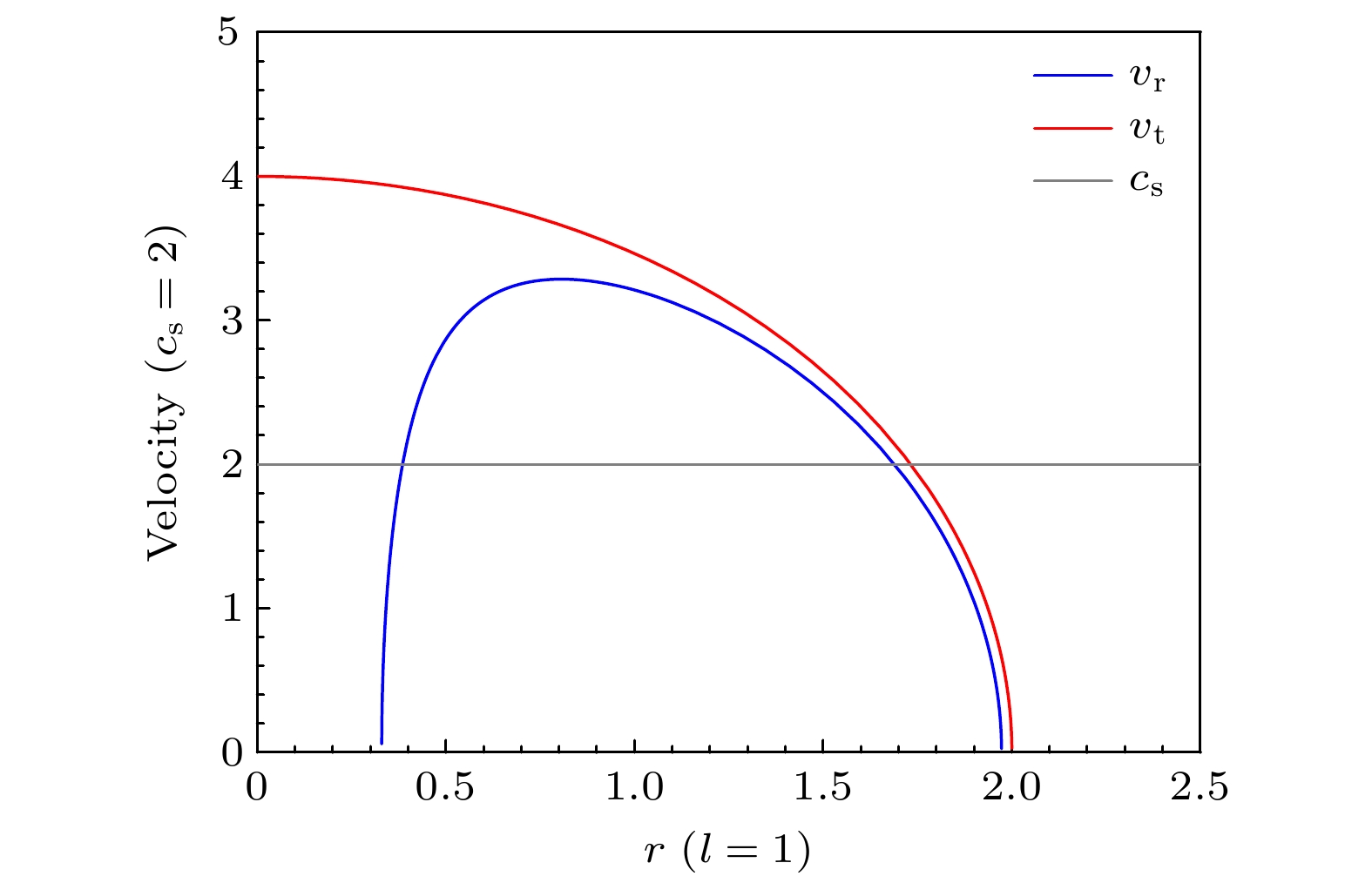




 下载:
下载:
